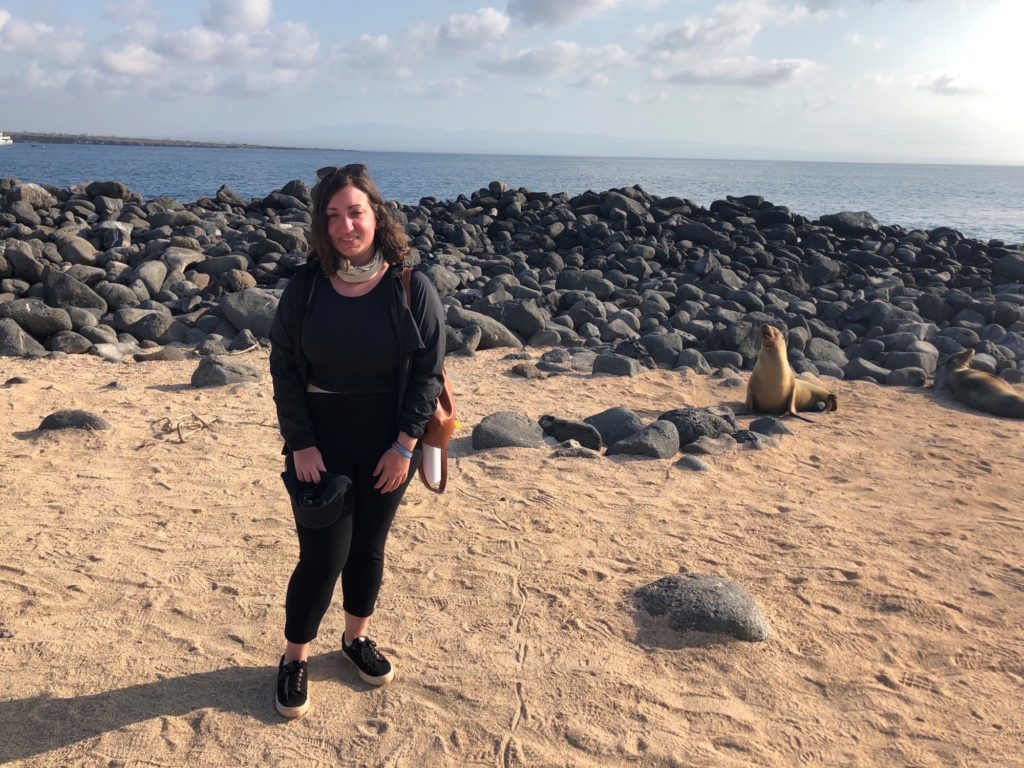
Following a 6:45 wakeup call and a 7:00 breakfast, my third day in the Galapagos started with a 10-minute panga ride to Cerro Dragón, Santa Cruz Island’s “Dragon Hill.” After a dry landing, we set out on a two-hour walk through dry, rocky trails bordered by cacti and trees oozing a delightfully fragrant sap that actually works as natural insect repellent.
This area of Santa Cruz gets the name “Dragon Hill” from the Galapagos land iguanas that make their home here, and they are definitely a sight to see. The land iguanas are enormous and very prehistoric looking – quite representative of the unique wildlife and cycle of evolution in the Galapagos.
The Galapagos land iguanas lounged on desert-like hills and in the shade provided by cacti and other plants, and some could be seen attempting (clumsily) to climb trees and get at higher vegetation to eat – a behavior our guide told us has been a recent adaptation born out of necessity that they’re still working on. During our walk around Cerro Dragón, we also came upon lagoons inhabited by flamingos picking around for foods like shrimp and algae, high in the keratin that’s responsible for the bright pink/orange color of their feathers.
We returned to the ship to relax, and I opted to tag along for an optional deep water snorkeling excursion. We took the pangas out into open water along the lava rocks at the edge of the island and jumped straight over the side. This excursion was recommended only for reasonably strong swimmers, as the water was somewhat choppy, but the encounter I had here ended up being the highlight of my time in the Galapagos. Two adult sea lions and a pup were lounging on a rocky ledge hanging over the water, and decided to hop in and go for a swim. All three sea lions then approached the other snorkelers and I and started playing with us. They would come up to within a foot or two of me, then dart away and circle around myself and each other. Having only really had the chance to see them rest lazily onshore, I was stunned by the incredible speed and agility with which they were capable of moving all that bodily mass underwater. This is what I came to the Galapagos for.
Later, the group took the pangas out to North Seymour Island for a two-hour walking tour. As was completely expected by this point, this island was another totally new experience, and it was dominated largely by birdlife. There were plenty of sea lions around, chilling on the brownish-red dirt paths, but the real show was put on by the frigate birds and blue-footed boobies.
All around us, they put on elaborate social displays to attract mates and looked after their eggs. Male frigate birds had the giant red air sacks on their chests inflated in hopes of catching the attention of a female flying by. My guide explained that the female’s decision isn’t actually based on the pouch itself; it’s based on the location and quality of the male’s nest, and the red pouch acts as a beacon to indicate his presence and to provide the female with a chance to come down and check out the nest. After she does this, the male flies away in search of a stick to bring back as an offering. If the female approves of the stick, she agrees to mate with him, and if not, she keeps looking, and he keeps trying. Love stinks.
However, the most remarkable thing about the visit to North Seymour was the display put on by the blue-footed boobies. Myself and the other people in my group were standing a foot away from mothers looking after their eggs, and they were so comfortable with our presence that they weren’t even suspicious of us in a situation as delicate as this. Equally close to us were male boobies doing their elaborate mating dances, ruffling their feathers, hopping around and letting out loud, competitive bellows. If I haven’t made this clear yet, the Galapagos Islands archipelago is a enchanting place.



